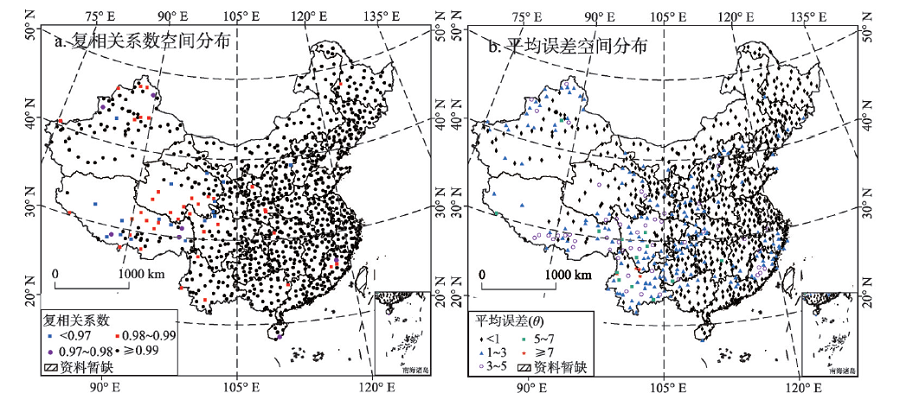

Spatio-temporal distribution of the climatic seasonsin China from 1961 to 2016
Received date: 2018-11-26
Request revised date: 2020-01-16
Online published: 2020-05-25
Supported by
National Natural Science Foundation of China(41561024)
National Natural Science Foundation of China(31760241)
Copyright
In this study, the spatio-temporal distribution characteristics of the climatic seasons in China from 1961 to 2016 are analyzed by using the climatic seasonal division standard (QX/T152-2012) issued by the China Meteorological Administration, the Chinese daily surface temperature dataset (V2.0, 0.5°×0.5°) issued by the National Meteorological Information Center, and the revised multiple regression model. The linear trend and extreme-point symmetric mode decomposition method (ESMD) are used to analyze the variations in the distribution area, durations, and start date of the climatic seasons. The main results are as follows. There are four climatic seasonal regions in China, namely, the perennial-winter, no-winter, no-summer and discernible regions, while there are no perennial-summer or perennial-spring regions. Considering the area variation of each region, the range of the perennial-winter region is significantly narrower, and the area of no-winter region increases, while the areas of no-summer and discernible regions have no significant changes. The regions with significant changes in the normal climatic seasons are mainly distributed in the Qinghai-Tibet Plateau and the Inner Mongolia Plateau. The regions with significant changes in the durations of the climatic seasons are mainly found in the northern China. The advance of the summer start date has led to a significant increase in the durations of climatic seasons in the central and western Inner Mongolia, Hexi Corridor and Xinjiang, and the postponement of the winter start date has resulted in a decrease in the number of winter days in these areas. In general, the climatic seasons at high altitudes in western China have more significant changes than those in the eastern coastal plains. Overall, the distribution and changes of the climatic seasons in China are revealed by this investigation, which could provide a reference for operational weather forecasting and climatic region division.

MA Bin , ZHANG Bo . Spatio-temporal distribution of the climatic seasonsin China from 1961 to 2016[J]. Acta Geographica Sinica, 2020 , 75(3) : 458 -469 . DOI: 10.11821/dlxb202003002
表1 不同气候基准期中国气候季节长度的多元回归模拟Tab. 1 Multiple regression models for the duration of climatic seasons in China for different climate normals |
| 气候基准期 | 气温界限(℃) | 多元回归模型 | 显著性水平 | |
|---|---|---|---|---|
| 1961—1990年 | 10 | 0.97 | 0.001 | |
| 22 | 0.958 | 0.001 | ||
| 1971—2000年 | 10 | 0.97 | 0.001 | |
| 22 | 0.958 | 0.001 | ||
| 1981—2010年 | 10 | 0.97 | 0.001 | |
| 22 | 0.959 | 0.001 |
图3 1961—2016年各气候季节分区面积占中国大陆面积比例及其变化趋势Fig. 3 The area proportions of different climatic seasonal divisions and the variation trend in China from 1961 to 2016 |
表2 1961—2016年各气候季节分区面积变化倾向率Tab. 2 The area-changing tendency rate of the climatic seasonal divisions in China from 1961 to 2016 |
| 常冬区 | 无冬区 | 无夏区 | 四季分明区 | |
|---|---|---|---|---|
| 倾向率(%/10a) | -0.69 | 0.22 | 0.08 | 0.39 |
| R2 | 0.69 | 0.15 | 0.01 | 0.18 |
| 显著性水平 | 0.001 | 0.01 | 无 | 无 |
| [1] |
|
| [2] |
|
| [3] |
|
| [4] |
|
| [5] |
|
| [6] |
|
| [7] |
|
| [8] |
|
| [9] |
|
| [10] |
|
| [11] |
|
| [12] |
|
| [13] |
|
| [14] |
|
| [15] |
|
| [16] |
|
| [17] |
[ 张宝堃 . 中国四季之分配. 地理学报, 1934,1:29-74.]
|
| [18] |
[ 严登华, 耿思敏, 罗先香 , 等. 中国北方地区四季的时空演变特征. 地理科学, 2011,29(9):1105-1110.]
|
| [19] |
[ 缪启龙, 王勇 . 中国四季的划分及其变化特征分析//中国气象学会2007年年会气候变化分会场论文集. 广州: 中国气象学会, 2007: 693-701.]
|
| [20] |
|
| [21] |
Department of Policies, Laws and Regulations of China Meteorological Administration. Assembling for Meteorological Standards 2012//Chen Yu, Jiang Yundi, Chen Xianyan, et al. Division of Climatic Season. Beijing: China Meteorological Press, 2013: 18-26.
[ 中国气象局政策法规司. 气象标准汇编2012//陈峪, 姜允迪, 陈鲜艳, 等. 气候季节划分. 北京: 气象出版社, 2013: 18-26.]
|
| [22] |
China Meteorological Administration. China Climate Change Bulletin in 2016. Beijing: Science Press, 2017.
[ 中国气象局气候. 中国气候变化监测报告(2016). 北京: 科学出版社, 2017.]
|
| [23] |
[ 刘玉莲 . 1961—2010年黑龙江省气候季节时空分布及其变化特征. 气象与环境学报, 2015,31(2):89-96.]
|
| [24] |
[ 程玉琴, 尤莉, 朱宇 , 等. 赤峰市气候季节划分方法及应用. 干旱区资源与环境, 2017,31(4):171-177.]
|
| [25] |
[ 陈城, 谷德高, 卢洋 . 1960—2009年武汉城区与郊区气候季节的变化. 气象与环境学报, 2015,31(1):96-100.]
|
| [26] |
[ 许艳, 唐国利, 张强 . 基于均一化格点资料的全球变暖趋缓期中国气温变化特征分析. 气候变化研究进展, 2017,13(6):569-577.]
|
| [27] |
[ 戴声佩, 李海亮, 罗红霞 , 等. 1960—2011年华南地区界限温度10 ℃积温时空变化分析. 地理学报, 2015,69(10):650-660.]
|
| [28] |
|
| [29] |
[ 王金良, 李宗军 . 极点对称模态分解方法: 数据分析与科学探索的新途径. 北京: 高等教育出版社, 2015.]
|
| [30] |
[ 李双双, 芦佳玉, 延军平 , 等. 1970—2015年秦岭南北气温时空变化及其气候分界意义. 地理学报, 2018,73(1):13-23.]
|
| [31] |
[ 王飞, 王宗敏, 杨海波 , 等. 基于SPEI的黄河流域干旱时空格局研究. 中国科学: 地球科学, 2018,48(9):1169-1183.]
|
| [32] |
[ 张世轩, 张璐, 孙树鹏 , 等. 全球变暖情况下中国季节的变化. 高原气象, 2011,30(3):659-667.]
|
/
| 〈 |
|
〉 |